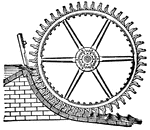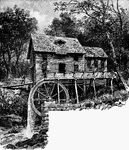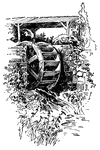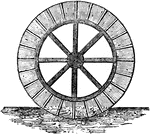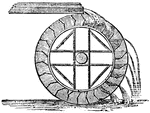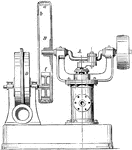Water Power Generation
This science ClipArt gallery offers 40 images of methods for producing power by water, including dams and water wheels.

Barker's Mill
The barker's mill is a device that rotates as water is poured in at top and comes out in opposite directions…

Breast Wheel
"In this water, instead of passing over, or entirely under the wheel, is delievered in the direction…
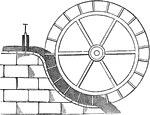
Breast Wheel
"Water enters the wheel halfway up and flows against the slots on the wheel. The wheel rotates with…
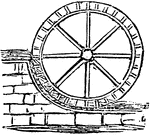
Breast-wheel
"A wheel turned by the force of water which is level with its centre." — Williams, 1889

Simple Dam
An illustration of a simple dam; a dam is a barrier that impounds water or underground streams. Dams…
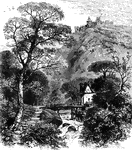
Mill on a Mountain Stream
A small mill sits on a briskly-flowing mountain stream. A footbridge crosses the stream. A larger building…

Overshot Wheel
"The Overshot wheel is a form of water wheel in which the water flows upon or near the top of the wheel.…
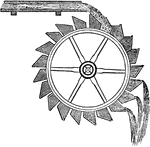
Overshot Wheel
"This wheel of all others, gives the greatest power with the least quantity of water, and is, therefore,…

Overshot Wheel
"Wheel consists of flaps in the shape of buckets that are equally spaced. As water flows onto the wheel,…
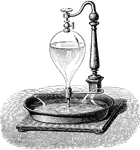
Tourniquet
Hydraulic tourniquet, also called Barker's mill. It consists of a vessel of water free to rotate about…

Turbine
"The most efficient form of water-wheel is the turbine, one form of which is shown." — Avery,…
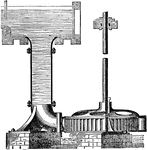
Turbine Wheel
"A waterwheel which the water enters and leaves at all points on its circumference." -Foster, 1921
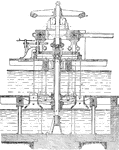
Girard Turbine
"The general sectionl elevation of a Girard turbine, in which the flow is axial. The water, admitted…
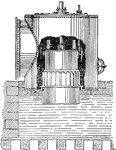
Hercules Turbine
"In the "Hercules" turbine...the flow is what is called mixed, that is, it is partly a radial inward…

Hydraulic Turbine
A turbine that uses moving water to make it work. They are used in hydroelectricity plants.
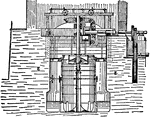
Jonval Turbine
"This turbine was designed to give 1250 H.P. with a fall of 25 ft. and an efficiency of 77%. It is fitted…
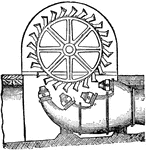
Pelton Wheel Turbine
"Turbine is, in mechanics, a term formerly confined to horizontal water wheels, the revolution of which…
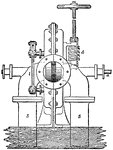
Reaction Turbine
"Professor James Thomson's inward flow or vortex turbine has been selected as the type of reaction turbines.…
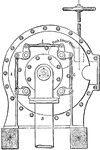
Reaction Turbine
"Professor James Thomson's inward flow or vortex turbine has been selected as the type of reaction turbines.…

Reaction Turbine
"Professor James Thomson's inward flow or vortex turbine has been selected as the type of reaction turbines.…

Reaction Turbine
"Professor James Thomson's inward flow or vortex turbine has been selected as the type of reaction turbines.…
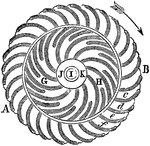
Water Turbine
"Water enters through J and K following into G and H compartments. Afterwards the water is forced into…
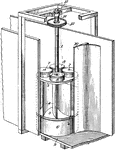
Water Turbine
Any of various machines having a rotor, usually with vanes or blades, driven by the pressure, momentum,…

Undershot Wheel
"Thus constructed, this wheel moves equally well whether the water acts on one or the other side of…
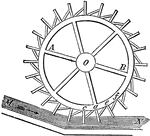
Undershot Wheel
"Waterwheel where the lowest flat-board is submerged in the running water. The water is often given…

Water Wheel
"When a water fall ranges between 10 and 70 feet, and the water supply is from 3 to 25 cubic feet per…

Water Wheel
An image of the overshot wheel that operates machinery by water power, receiving water at the top.

Water Wheel
An image of the breast wheel that operates machinery by water power, receiving water opposite the axle.
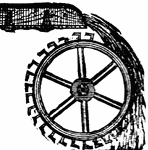
Water-wheel
Any wheel for propelling machinery or other purpose, that is made to rotate by the direct action of…
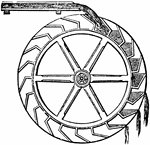
Water-wheel
"A wheel driven by water shot over the top. The buckets of the wheel receive the water as nearly as…

Overshot wheel
"In the overshot wheel, the water falls into buckets at the top, and by its weight, aided by the force…
